This movie is a big deal, in cannibal studies.
When you hear terms like “video nasties” or “grindhouse”, Cannibal Holocaust tends to be high on the list of titles mentioned. The film’s violence was extreme in 1980, although it has certainly been exceeded since then, with the “benefit” of CGI special effects. The scenes of death and cannibalism were enough to get the director, Ruggero Deodata, arrested for suspected murder, as he had arranged for the actors to go underground to give the impression that, just maybe, he had gone for the ultimate in cinéma vérité: a snuff movie. Where the film remains at the cutting edge (sorry) of extreme cinema even today was in its presentation of authentic animal cruelty, in the midst of fictional human deaths. For this it was widely condemned, even by those who otherwise enjoyed the film, and it was banned in several countries, including Italy and Australia. The best part of the film is probably Riz Ortolani’s stunning soundtrack. But in the end, I must grudgingly say that Cannibal Holocaust is a film more relevant than ever – because it is a direct indictment of “fake news”.

At a time when news stories were increasingly becoming sensationalist beat-ups, and the American failure in the Vietnam war was still being blamed on the ubiquitous media coverage of the gruesome results of that conflict, Deodato is asking the question: “what can we believe”? Or, as the protagonist of the film, anthropologist Harold Monroe (Robert Kerman) asks in the last few frames
“I wonder who the real cannibals are?”
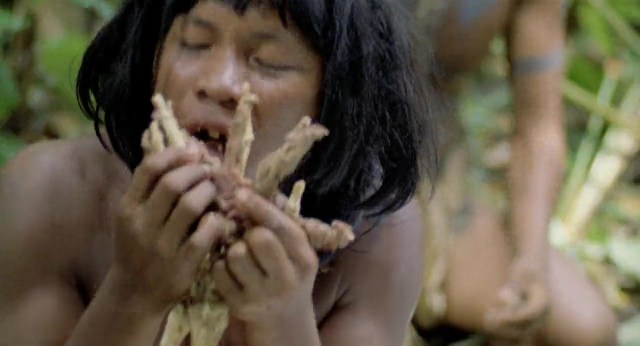
This is the question that every cannibal film or TV show asks, in its own way. Hannibal Lecter denies he is a cannibal in season 3 of Hannibal (I’ll get to it in a couple of months) when he tells a victim, whose leg they are both eating:
“This isn’t cannibalism, Abel. It’s only cannibalism if we’re equals”.
Cannibalism is about power and appetite. Those we accuse of cannibalism, in this case the indigenous peoples of the Amazon, were in all probability never cannibals. The imperialists who came in search of gold, like Columbus, or oil or timber or news footage were the real consumers – of humans who had been transformed into commodities and resources. Cannibal Holocaust asks us to think about what, in the panorama of abuse, death and torture that surrounds us, is real?
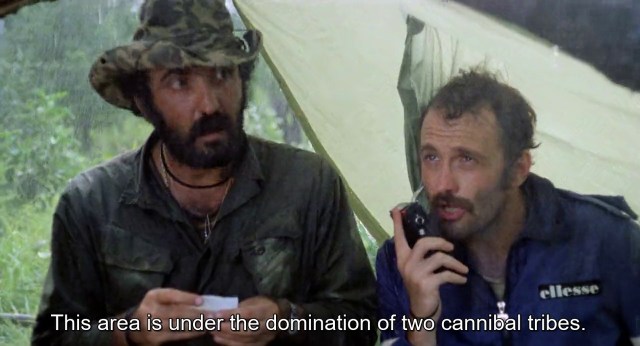
This wasn’t the first Italian cannibal film: that was Man From Deep River. It wasn’t even Deodato’s first cannibal film, which was Last Cannibal World (Ultimo Mondo Cannibale). He had gratuitous animal cruelty in that one too. But Cannibal Holocaust asked new questions about the media in which it was made, about the motivations of the documentary, and about what Deodato himself was doing.
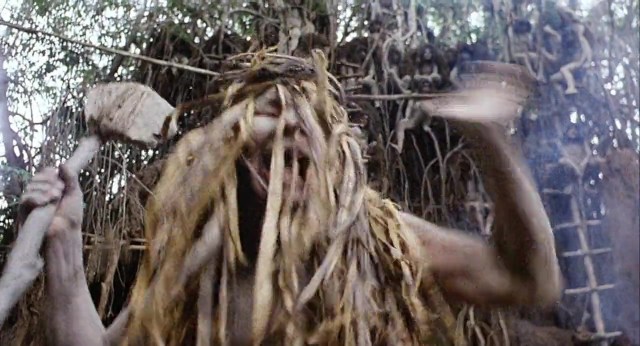
The film is told from the viewpoint of an anthropologist, Monroe, who is asked to go to the Amazon, to the area frequented by cannibal tribes and known as the “Green Inferno” (a name that spawned a tribute movie 33 years later). His mission is to find out what happened to four young American film-makers who disappeared there without a trace. Well, guess who came to dinner?

The first half of the film is Monroe negotiating with the locals, watching a rape and murder, helping eat an adulterer, shooting several natives, and finding and recovering the cans of film that have survived the whole sordid adventure. And yes, making friends, but not enjoying dinner with the cannibals.
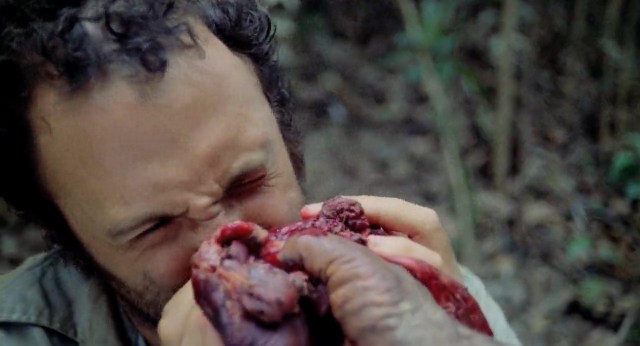
The second half of the film purports to show that recovered film, which a television network wants to show uncut to the public to sensationalise their deaths. This part is often referred to as the forerunner of the “found footage” movies that became enormously popular later with Blair Witch Project. In fact, Punishment Park (Watkins, 1971) was probably the first found footage film, claiming that its story of anti-war protesters being dumped (and filmed) in the California desert is actual newsreel. But in that period, what was genuine newsreel footage was on television every night, and showed dead American soldiers, burning Vietnamese civilians, and Kent State University students being gunned down by the National Guard. The difference between real and fake news was becoming opaque, years before the time of Trump (in fact, when he was still busy avoiding the draft). Deodato said he believed a lot of the news reports of Red Brigade terrorism in Italy had been staged for the cameras. In any case, even in unvarnished reporting, the framing of the camera and choice of which shots to use make the concept of real, impartial news unattainable.
Who were the cannibals? The ones depicted as real savage cannibals in Cannibal Holocaust were described by Francesca Ciardi, who played Faye, one of the lost American filmmakers, as:
…perhaps the sweetest people I have ever met. The cannibals were just local people. They put wigs on them but in real life they were very clean people: they worked in offices and they wore well-pressed shirts”.
The most controversial legacy of this film is the appalling animal cruelty. Deodato juxtaposes brutal violence on humans (rape, murder, cannibalism) through special effects, while filming live and in gory detail the killing of a coatimundi, a giant turtle, a monkey (whose brains are eaten while still alive), a tarantula, a snake and a pig. When their guide gets bitten by that snake, we get “live action” of them chopping up the snake, then chopping off the man’s leg. The team make sure the camera is rolling before wielding the machete.
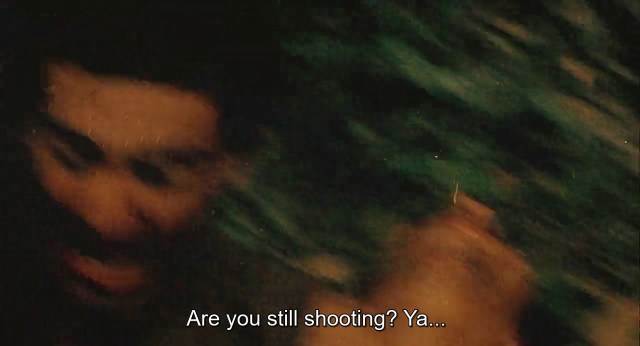
What is he trying to achieve through this collision of fake human and actual animal deaths? Is it simply to try to extend the illusion that, just perhaps, these shaky images were indeed real footage, and the actors were dead? Well that didn’t last past his murder trial, where he had to produce them in the court in order to be exonerated.
Critic and media academic Calum Waddell points out that this movie shows vile and debased behaviour on both sides – the ‘savage’ natives and the ‘civilised’ Westerners. But the Americans are punished for it – they are eventually killed and eaten for their troubles. The natives? A few get shot or burned, but there is no judgement. Waddell calls this a “fascist perspective”, because white people shouldn’t act like this, and so get punished, but the “savages” – well, that’s just the way they are. We can’t expect better of them, and in fact the Americans, when they first land, young, strong and white, are the picture of gung-ho adventurers, seemingly invincible. Then they regress into savagery, as they trek deeper into the green inferno.
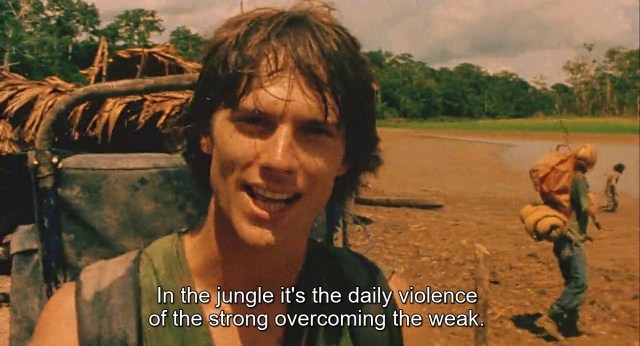
They (the savages) are cannibals by nature, and we (the civilised) risk becoming like them. The civilised whites lose their humanity as they enter the inhuman world of the cannibals, just as American troops in Vietnam lost theirs as they became enmeshed in that jungle war and started to massacre villagers. The film crew set fire to the native village so they can film an imaginary war between tribes. They capture a young girl and rape her just for fun, then film her body, impaled on a stake for losing her virginity.
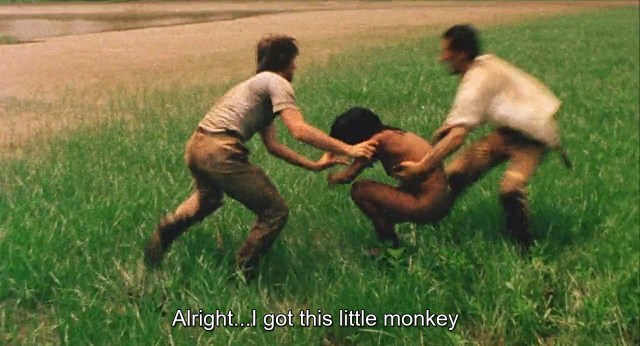
Cannibal Holocaust documents the loss of belief in the inevitable progress of humanity, usually told through the invincibility of white privilege.

The Americans film everything, even their own death at the hands of the infuriated natives. The interlopers act as imperialists always have, but now they get eaten for it.

To complicate the question of truth or simulation, we are shown a series of clips that the Americans are said to have recorded earlier in their careers, which we are told were staged for the cameras. These were clips of actual executions and abuses that Deodata presents here as fake news, created to be sensationalist newsreels.
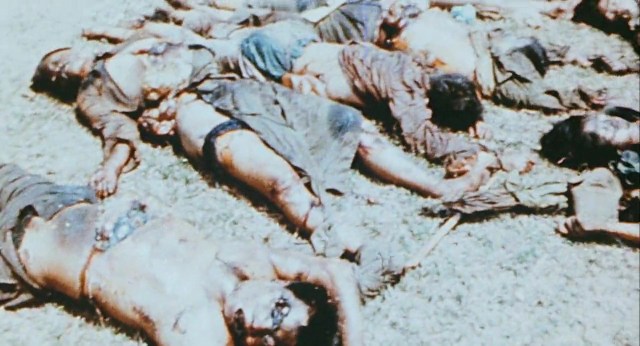
So now we have Deodato playing with our heads: real human executions are presented as fake, while fake rape and killing is presented as real. Real animal abuse, insisted upon by the director, is accompanied by gallons of human gore and agony which we know is fake. Monroe is told: “Today people want sensationalism.”
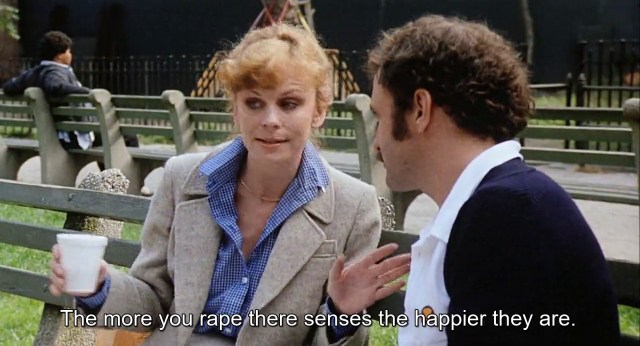
Yet the roller-coaster of fact and fake does not really work. Did Deodato really expect people to file out of the cinema (when it was finally shown after years of censorship) scratching their heads and saying “those guys really did get eaten! Damn shame.” The scenes of actual vicious killings of animals seem meant to drive home the point that, just maybe, the deaths of the young Americans are real too. But, as Waddell points out, the coatimundi is killed in the first half, which is unequivocally a fictional presentation (or at best re-enactment) of the expedition to find the lost tapes. So that creature’s death is totally gratuitous.
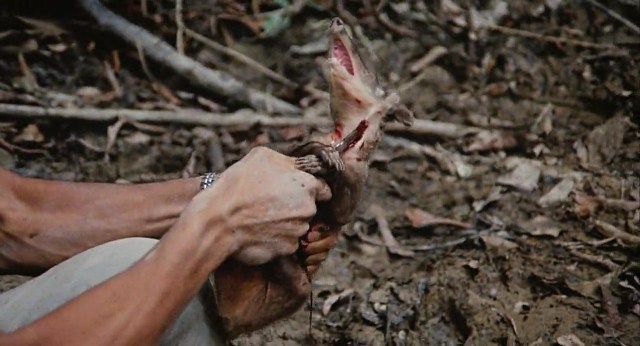
Or is it? Deodato seems to be saying: don’t swallow anything you see on screen.
Here’s the thing. Real atrocities go on, but usually in the dark, or behind walls, at least not near any cameras. The Americans catch and chop us a giant turtle who continues to move as his head is removed and he is disembowelled.
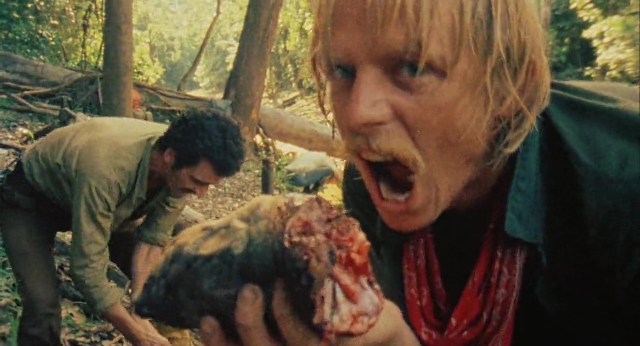
We can be squeamish at the death of that beautiful turtle – Faye is filmed throwing up as they chop the animal’s head off, but then we see her biting into the cooked meat soon afterwards.

The turtle died totally unnecessarily for the sake of a cheap movie shot. We can also be sickened by the scenes of rapes and murders of humans, which are fake, but look pretty real. But every moment, as we reach for the remote and gratefully turn off the movie, real atrocities are continuing everywhere, in wars and domestic abuse and abattoirs and laboratories. Real animals quiver in their death throes, millions of them every second, while we turn our faces away from the dying turtle. We are not filming those abuses, but very often we are paying for them, through our taxes or our shopping. Like Faye, the cruelty repels and nauseates us, but the appetite makes us forget. This film, perhaps, helps us to remember.


Pingback: “The most violent film ever made” – CANNIBAL FEROX (Lenzi, 1981) – The Cannibal Guy
Pingback: Cannibal – the game (Deodato 2020) – The Cannibal Guy
Pingback: Meat is meat! THE BUTCHERS (Paulmichel Mielche, 1973) – The Cannibal Guy
Pingback: Cannibal News June 2021: SWISS COURT SENTENCES CANNIBAL TO 20 YEARS – The Cannibal Guy
Pingback: Vietnam vets and cannibals: CANNIBAL APOCALYPSE (Antonio Margheriti, 1980) – The Cannibal Guy
I couldn’t find the words to describe the varying feelings this movie put me through, but you worded it so perfectly. I wish I didn’t watch it, but at the same time, I’m almost thankful I did? Everything about it is nauseating, the treatment the white, young filmmakers have towards the natives, the brutality of the animals, and – of course – the cannibalism. Although I hate the say it, there is one redeeming quality of the film, and that is, of course, the final line, “I wonder who the real cannibals are.” I reckon it’s us? – the viewers? Those of us who watch so many horror films that we become numb to them and need something of this caliber to disgust or rattle us. We have the appetite you discuss and are fed it via film and media sensationalization, yet we turn a blind eye to the atrocities that are happening in our own world. Why do we watch rape and ethnocide on our televisions for entertainment, but ignore the same events that take place in the real world? I just finished watching this film, regrettably, on YouTube and the comments were less than upsetting. “I’ve seen worse,” “you think this is bad?” and other self-praising comments that ultimately mean they no longer find the horrors of this film to be genuinely horrifying. I don’t know what’s worse: I watched this film or that others are bragging about easily watching something more horrifying than rape, ethnocide, murder, cannibalism, real animal cruelty, etc. I believe I will be taking a break from horror films, especially now that I see myself as the “real [cannibal].” So I suppose Deodato won in my case.
LikeLiked by 1 person
Pingback: Satanic rituals and forced cannibalism. How many refugees share this fate? – The Cannibal Guy
Pingback: “It’s primitive as can be”: GILLIGAN’S ISLAND (1964-67) – The Cannibal Guy
Pingback: Serving your crew: DREAD HUNGER (eight-player cannibalism game) – The Cannibal Guy
Pingback: Cannibalism in the Ukraine: GHOUL (Petr Jákl, 2015) – The Cannibal Guy
Pingback: Revenge cannibalism: LAST HOUSE ON THE LEFT (Wes Craven, 1972) – The Cannibal Guy
Pingback: Criminals, rapists and cannibals: Donald Trump and the immigrants – The Cannibal Guy